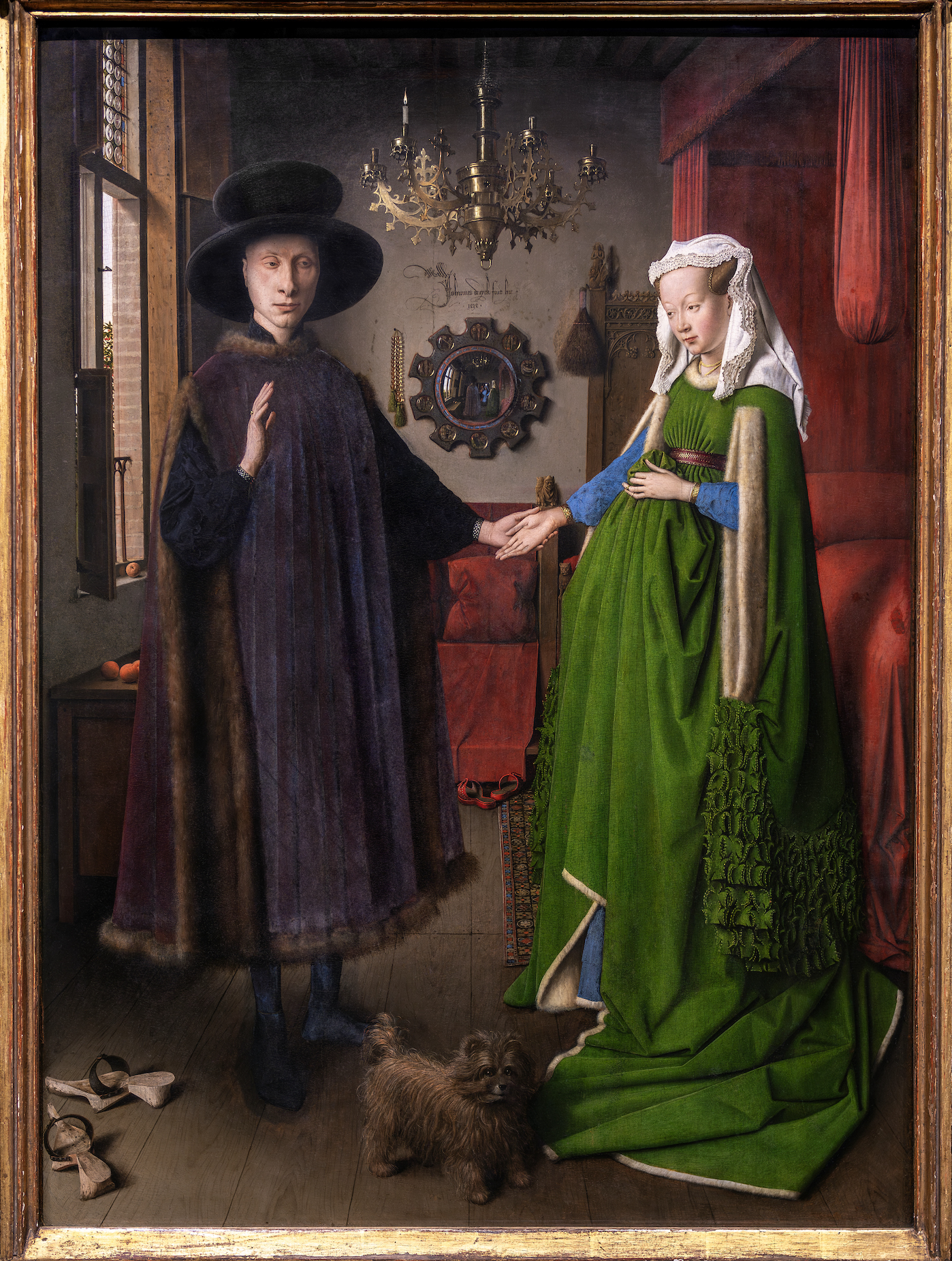Renaissance

Northern Renaissance Art
First Glance
Was the first thing you noticed the woman holding her upper stomach? If not, I bet you went back to look. She is indeed not pregnant. During the Northern Renaissance Painting era, it was considered disrespectful to paint or involve pregnancy in any other form of art of pregnant women. However, there are the subtle hints that this woman is soon to be with child. Let's talk about these symbols.
Finding the Subtle Hints
During the time that this painting was created, dating back to 1434, women often married young and took care of the children. One of the subtle hints that are dropped are the ripe oranges to the left. Although, you cannot see there is also a wooden statue of Saint Margaret on the bed frame. These two are said to symbolize that soon the girl in the photo would soon be with child or is ready to have children.
Dressing Like A Grandma
Often, women are dressed so much bulkier and colorful than those they stand next to. The way that a woman was dress often revealed the amount of income that their significant other was making. There are also times where they are dressed based on the situation from being with-child or to portray the wealth that they are blessed with. This may seem like an oil painting symbolizing a wedding, however, if you look deeper you can see that they are in a bedroom. However, it is said that this is merely a painting in remembrance of his late wife.
About The Portrait
This famous painting is an oil based painting on an oak panel. The statement of humanism in this painting defines that others is individual dignity and building themselves up. During this time women were admired that they were able to carry children and take care of them. All while men were acknowledged for bringing the bread to the table for their family that they have created.
Thoughts
Personally, I would not hang art older than me in my home. However, I am impressed by all the things that I learn about art in the old days and how creative the artists were when hiding the most obvious symbols. I really admire how colorful the women were compared to man back then. I just want to know how valued women were during this time because they are painted so beautifully like they were admired.
Citation
Steenbakkers, Piet. “Human Dignity in Renaissance Humanism (Chapter 6) - the Cambridge Handbook of Human Dignity.” Cambridge Core, Cambridge University Press, 2014, www.cambridge.org/core/books/abs/cambridge-handbook-of-human-dignity/human-dignity-in-renaissance-humanism/26A10C6FB0CA3BC17ACE841DD0345CAF.
Harris, Beth, and Steven Zucker. “Jan van Eyck, the Arnolfini Portrait.” Smarthistory, 16 Jan. 2025, smarthistory.org/jan-van-eyck-the-arnolfini-portrait/.
Bone, Ella. “Jan Van Eyke, the Arnolfini Portrait and Humanism.” Humanismartsblogger, 3 Aug. 2015, humanismartsblogger.wordpress.com/2015/08/03/jan-van-eyke-the-arnolfini-portrait-and-humanism/.
Wanderer, Art. “The Arnolfini Portrait: A Closer Look.” The Art Wanderer, 19 Apr. 2022, theartwanderer.co.uk/jan-van-eyck-the-arnolfini-portrait/.
“The Arnolfini Portrait by Jan Van Eyck: Great Art Explained.” Edited by Great Art Explained, YouTube, YouTube, 30 Aug. 2020, www.youtube.com/watch?v=T15Kv6dtYO0.


This comment has been removed by the author.
ReplyDeleteYour analysis was wonderful! I loved the question you asked in the beginning. It definitely fooled me.
ReplyDeleteI find the information on pregnancy interesting, and I definitely share your question on how admired women were at the time. Something I couldn't help but notice compositionally, is that the vibrant greens of the woman's dress directly compliments the robust reds of the environment, adding to the vibrancy and energy of the piece, while also seeming to make the woman a center piece. It really focuses in on the idea that the women were meant to outshine whoever they stood next to- and this value is represented in how the male figure seems to blend into the environment, save for his pale face. His darker clothes don't build the same visual interest, save for hints of reds and purples layered in his clothes. Overall, it's such an interesting piece and I love the extra layer of history that goes with it!
Firstly, I just want to say how much I adore your blog and all the hard work that has gone into maintiang and making it look so clean and polished. Secondly, in your third paragraph, where you speak about how women dress with larger and more colorful clothing to signify their husbands, it was a fact that I did not know about till today. Their clothing being bulky and larger was appropriate for the time period of the early Renaissance, and I am glad someone was able to bring the larger clothing that women wore into the front light of their blog. Something I had found that you might have missed as a hint to her being with child is her hand upon her stomach as those she is craddling her unborn and telling them that they will meet soon. She might be getting a blessing from a preist for her child to be born healthy and strong as well.
ReplyDelete